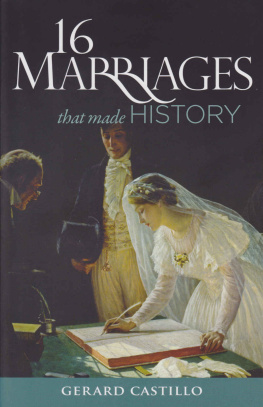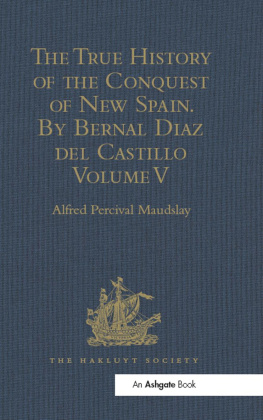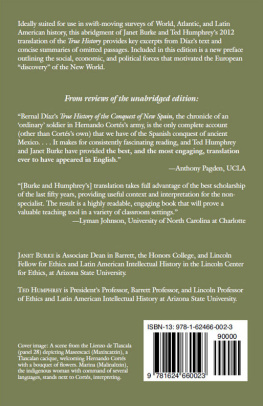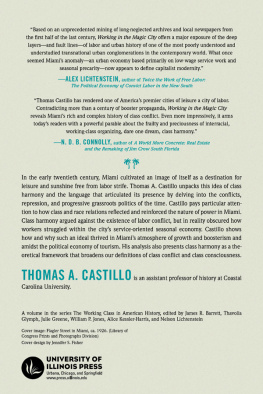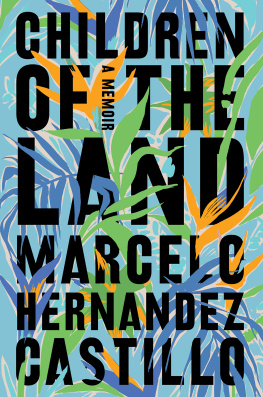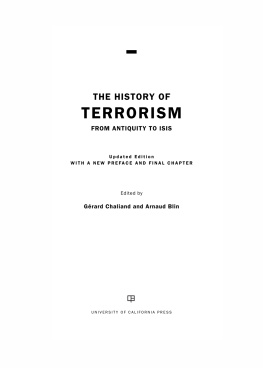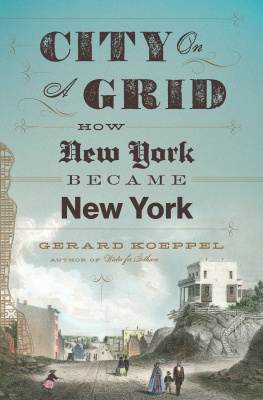Gerard Castillo - 16 Marriages That Made History
Here you can read online Gerard Castillo - 16 Marriages That Made History full text of the book (entire story) in english for free. Download pdf and epub, get meaning, cover and reviews about this ebook. year: 2017, publisher: Scepter Publishers, genre: Religion. Description of the work, (preface) as well as reviews are available. Best literature library LitArk.com created for fans of good reading and offers a wide selection of genres:
Romance novel
Science fiction
Adventure
Detective
Science
History
Home and family
Prose
Art
Politics
Computer
Non-fiction
Religion
Business
Children
Humor
Choose a favorite category and find really read worthwhile books. Enjoy immersion in the world of imagination, feel the emotions of the characters or learn something new for yourself, make an fascinating discovery.
- Book:16 Marriages That Made History
- Author:
- Publisher:Scepter Publishers
- Genre:
- Year:2017
- Rating:5 / 5
- Favourites:Add to favourites
- Your mark:
- 100
- 1
- 2
- 3
- 4
- 5
16 Marriages That Made History: summary, description and annotation
We offer to read an annotation, description, summary or preface (depends on what the author of the book "16 Marriages That Made History" wrote himself). If you haven't found the necessary information about the book — write in the comments, we will try to find it.
16 Marriages That Made History — read online for free the complete book (whole text) full work
Below is the text of the book, divided by pages. System saving the place of the last page read, allows you to conveniently read the book "16 Marriages That Made History" online for free, without having to search again every time where you left off. Put a bookmark, and you can go to the page where you finished reading at any time.
Font size:
Interval:
Bookmark:


Copyright 2015 by Gerard Castillo
16 Marriages That Made History is an English translation and adaptation of 21 Matrimonios que Hicieron Historia, copyright Ediciones Rialp, S.A. Madrid, 2015.
The total or partial reproduction of this book is not permitted, nor its informatic treatment, or the transmission of any form or by any means, either electronic, mechanic, photocopy or other methods, without the prior written permission of the owners of the copyright.
Scripture texts from the New and Old Testaments are taken from The Holy Bible Revised Standard Catholic Edition 1965 and 1966 by the Division of Christian Education of the National Council of the Churches of Christ in the United States. All rights reserved. All copyrighted material is used by permission of the copyright owner. No part of it may be reproduced without permission in writing from the copyright owner.
English edition, copyright 2015 by Scepter Publishers, Inc.
P.O. Box 1391
New Rochelle, NY 10802
www.scepterpublishers.org
Cover and text design by Rose Design
ISBN: 978-1-59417-233-5
Printed in the United States of America
Contents
Many books have been written about the individual lives of extraordinary individuals, but there are very few about the shared lives of these people in the marriage setting.
It has been said that behind every great man, there is a great woman (and vice versa). Although this is somewhat of a clich, there is considerable truth in it. Actually it is almost impossible to write a good biography of a married person without taking into account the relationship with his or her spouse, especially when that relationship was faithfully maintained during many years, to the end of the persons life.
In this sense the life of famous men who owe a large part of their success to the hidden and self-sacrificing help of their spouses is very significant. In this book there are a number of examples: G.K. Chesterton, Jacques Maritain, Emperor Charles of Austria, J.R.R. Tolkien, and Baudouin I of Belgium.
This book is the result of research into the stories of a series of extraordinary persons linked to spouses who are also extraordinary. They were chosen with two criteria: being important figures in an historical epoch and having lived a beautiful and meritorious story of conjugal love. Six of these couples were monarchs and four were writers. To them are added one example each of persons devoted to such activities as craftsmanship, history, politics, and science.
The majority married for love. Several were political marriages or marriages of convenience that were transformed into marriages of love. For example, Louis IX of France and Marguerite of Provence were married without having met each other. In this case a love arose between them that remained alive till death. While its clear that the process followed here was neither orthodox nor recommended, it does provide us with a lesson: Good will on the part of both partners is always positive and, at times, works miracles.
The book also has cases of love against the current that survived the tragedy of war or overcame differences of age or personality.
An awareness of a constant history of marriages that are united, faithful, and happy in the midst of great difficulties is a valuable reference for the present-day debate over the institution of marriage. The testimonies gathered cover a very broad spectrum of historical periods from forty years after the birth of Christ until 1960. At the start of each chapter, the date of the couples wedding is included in parentheses.
I hope that the description of these marriages will help to restore and instill confidence in this natural institution in the face of the many accounts of failed marriages that predominate today.
The original Spanish edition of this book featured twenty-one marriages.

T he little we know of Aquila and Priscilla comes from sacred Scripture. They are mentioned three times with great praise in the Acts of the Apostles (18:23, 18, 26) and three times in the Epistles of St. Paul (Rom 16:3; 1 Cor 16:19; 2 Tim 4:19).
Within a few years following the death and resurrection of Christ, the seed of the gospel had spread through many regions of the Roman Empire. In Rome it was accepted by some Jews, among them Aquila and Priscilla, who converted to Christianity sometime around AD 40, after the gospel had been preached by St. Peter and before they met St. Paul. Both Aquila and Priscilla were disciples and collaborators with St. Paul from AD 50, carrying out a very active evangelizing role in the beginnings of the Church.
Aquila was a native of Pontus. He took his name from the Latin, as did many Jews living in the Roman Empire. He was a tent maker who had established his business in Rome, from which he and Priscilla had been expelled by an edict of Emperor Claudius in AD 49. The Roman historian Suetonius says that the edict was a result of disorders in the Jewish community over the question of Christ.
The name Priscilla is a diminutive of Prisca, which is the name that Paul uses in his letters. She was a Roman citizen, and an old tradition claims that she was a relative of Senator Gaius Marius Cornelianus, who provided lodging for St. Peter in Rome. There are also some ancient paintings of St. Peter administering baptism to a girl named Prisca.
Priscilla accompanied her husband on many trips. Her zeal to spread the Gospel made her stand out alongside Aquila. She is mentioned in Scripture seven times by her own name. In four of these places, her name comes before her husbands, which indicates that she was well known for her apostolic activity. She was also a well-educated woman who helped instruct Apollo, a very learned Jewish-Christian.
When they were forced to leave Rome, Priscilla and Aquila moved to Corinth, the capital of Achaia, situated between the Adriatic and Aegean seas. Because of its strategic position between East and West, it was one of the great metropolises of the Roman Empire. It was a religious, shipping, and commercial center.
There the young emigrants had to earn their living among the Greeks, Romans, Africans, Jews, all with different traditions and mentalities. Corinth was a center for textiles and dyeing (especially purple). Thus they were able to establish their tent-making business and had a number of employees.
A few months after arriving at that large cosmopolitan city, they were visited by a traveler from Athens who asked if he could stay at their house. It was Paul of Tarsus who arrived exhausted by the lack of understanding of his apostolic work by the Athenians. Years later he recorded it in this way: I was with you in weakness, with fear and in much fear and trembling (1 Cor 2:3). Paul went to Corinth with the intention of beginning a Christian community there.
Aquila and Priscilla were in sync with Paul from the first moment, since they shared, in addition to the Christian faith, the same profession. They joyfully accepted him into their own home and provided him with a job in their workshop. The couple worked intensely with Paul in the spreading of the faith and gathered the converts in their home, to the point that they constituted a small church. Thus began the Church of Corinth, with a missionary team composed of the apostle and a married couple.
Next pageFont size:
Interval:
Bookmark:
Similar books «16 Marriages That Made History»
Look at similar books to 16 Marriages That Made History. We have selected literature similar in name and meaning in the hope of providing readers with more options to find new, interesting, not yet read works.
Discussion, reviews of the book 16 Marriages That Made History and just readers' own opinions. Leave your comments, write what you think about the work, its meaning or the main characters. Specify what exactly you liked and what you didn't like, and why you think so.

